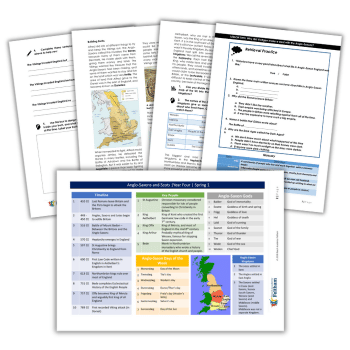24-page PDF including timeline, key facts and six lessons
KS2
Year 4
This 24-page Anglo Saxons KS2 PDF is designed for Year 4 history. It includes a timeline, key facts and six lessons to work through, with worksheets to complete.
This Anglo Saxons KS2 pack contains:
- Timeline from 410 CE to 789 CE
- List of key people, including St Augustine, King Aethelbert and Bede
- Lists of Anglo-Saxon days of the week, gods and kingdoms
- Glossary
- Retrieval practice worksheets
Each separate lesson contains lots of information about the Anglo-Saxons, plus activities for children to try. These include discussion activities, questions to answer, maps to label and so on.
Six Anglo Saxons KS2 lessons
How do we know about the Anglo-Saxons?
We have lots of written evidence of what life was like during Roman Britain because the Romans were so good at keeping written records.
However, after the Romans left Britain in around 410 CE we don’t have much writing from England. We know that lots of people invaded England and there was lots of fighting, but the facts aren’t clear.
Sometimes this period is called the Dark Ages because historians find it difficult to be really sure about events that took place. Although we don’t much writing, we do have some archaeological evidence – artefacts and buildings that have been excavated. For example, in 2010, a huge collection of treasure from this time was discovered: the Staffordshire Hoard.
Why did Vortigern make a deal with the Anglo-Saxons?
With the Romans gone, the Britons were very vulnerable to attack. The Scots would cross the Irish sea and raid Wales and the west of England. The Picts would attack from the north and raid the northern English towns.
The Britons couldn’t fight back effectively against the Scots or the Picts. They needed help. Just across the North Sea in Europe, three barbarian tribes were very effective fighters: the Jutes, the Angles and the Saxons.
Bede and Gildas both wrote that an English Chief called Vortigern (Vortigern actually means Great Chief) invited these tribes to England to help them fight against the Scots and Picts.
In return, the British paid tribes gold and gave them land in the south and east of England. Many people in these tribes wanted to move to Britain anyway because there was not much farmland where they lived.
What was life like for Anglo-Saxons?
Whilst living in England, the Romans had established large towns and cities with buildings made out of stone and brick. They built large bathhouses and villas.
The Anglo-Saxons chose not to live in these cities. Instead, they moved out into the countryside and built much smaller houses with lots of land to farm.
These villages would be centred around a larger house called the hall, where the chief would live. Most people at this time were farmers or ‘ceorls’: they grew crops and kept animals.
What did the Anglo-Saxons believe?
The Anglo-Saxons were pagans. They brought their own gods and goddesses – those of Norse mythology. The main God was Woden, who is similar to the Viking god Odin. Lots of the Anglo-Saxon gods and Viking gods were similar.
Each god represented a different part of nature, or something important to people living at that time.
What was the heptarchy?
By about 600 CE, England had split into seven clear kingdoms. We call the seven kingdoms the heptarchy. Each had their own king, who made laws and protected his people.
They would invade each other’s lands, and sometimes one king would claim to be the leader of all of Britain, or the Bretwalda. It would be difficult to keep control of the whole country, because of the large area.
Why did the Anglo-Saxons build forts?
From the 8th century, new invaders – Vikings – were sailing to England to raid the villages near the coast. These invaders meant that the Anglo-Saxons sometimes had to work together to fight them off.
Alfred the Great built ‘burhs’ – huge forts with high walls around them. They were very difficult to attack and could be easily defended by the people inside.
Jon Hutchinson is director of training and development at the Reach Foundation. Before this, Jon was a primary school teacher and assistant headteacher at Reach Academy Feltham. Download an Anglo-Saxon homes worksheet for KS2.














